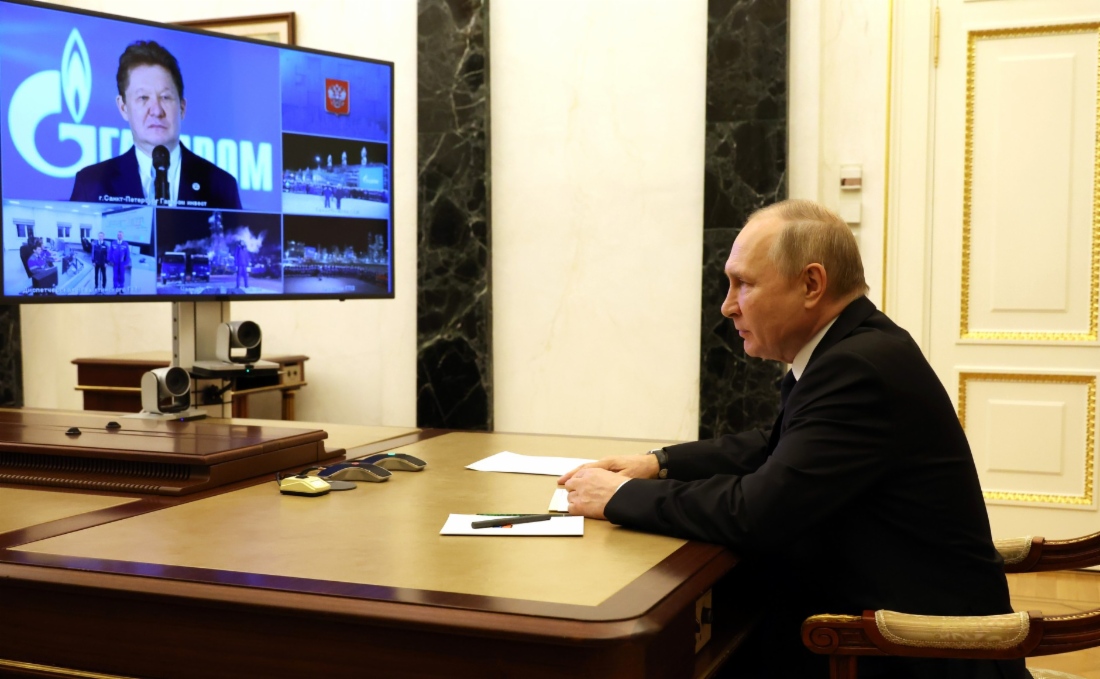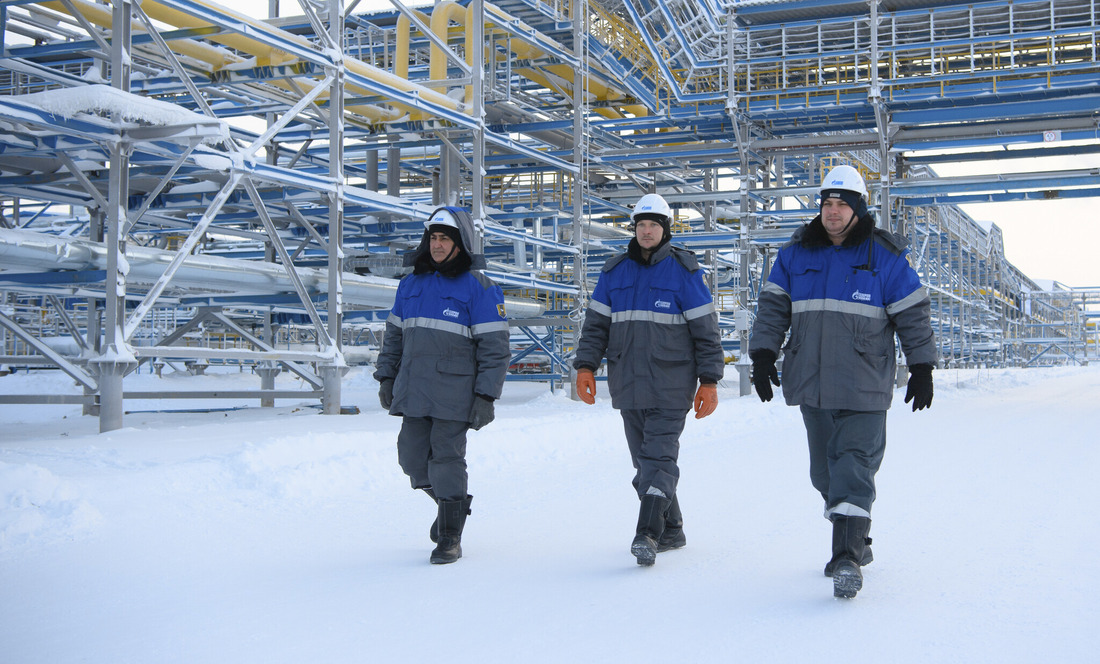Kovyktinskoye field and section of Power of Siberia gas pipeline enter operation
Today, the ceremony was held for the launch of the and the section of the gas trunkline between the Kovyktinskoye and Chayandinskoye fields.
Vladimir Putin, President of the Russian Federation, and , Chairman of the Gazprom Management Committee, took part in the event via a conference call.

During ceremony. Photo by kremlin.ru
The Kovyktinskoye field has the largest gas reserves in Russia. It is the key field for the Irkutsk gas production center and, together with the in Yakutia, forms the resource base for the Power of Siberia gas pipeline.
The top-priority infrastructure facilities for full-scale production are ready at the Kovyktinskoye field. They include, first of all, the comprehensive gas treatment unit No. 2 (CGTU-2), which is a high-tech complex with a total area of 800,000 square meters and an annual capacity of more than 6 billion cubic meters of gas. The facility receives hydrocarbons from the field's production wells and provides the treatment of the hydrocarbons to remove water, as well as mechanical impurities and other solids from them in order to ensure that the quality of gas complies with the stringent requirements set by Gazprom's standards. A high level of automation based on domestic systems makes it possible to manage the production processes remotely and ensures complete safety.
After another three CGTUs are launched, gas production from the field will be brought to its annual design level of 27 billion cubic meters.
The treated natural gas is fed into the Power of Siberia gas trunkline. To that end, the gas pipeline section between the Kovyktinskoye and Chayandinskoye fields was built, stretching for 804 kilometers and connecting Kovyktinskoye and Chayandinskoye. In order to receive the gas being transmitted from the Kovyktinskoye field, the second workshop of the Central booster compressor station was put into operation at the Chayandinskoye field. The station maintains the pressure required for further transmission of gas.
Another important product to be obtained from the Kovyktinskoye field is gas condensate, which is a valuable raw material for producing motor fuels and plastics. The infrastructure for gas condensate stabilization and its transportation to industrial enterprises is in place at the Kovyktinskoye field. Said infrastructure includes the condensate pipeline stretching for 173 kilometers and the railway shipment terminal in the Okunaysky town adjacent to the Baikal-Amur Mainline.
The pre-development operations at the Kovyktinskoye field were performed in complex climatic and geological conditions: low temperatures, rocky ground and clay soils, as well as altitude differences of up to 400 m. The use of modern domestic technologies and control methods made it possible to complete the construction-and-installation works at CGTU-2 in less than two years, which is a record-short time for the national gas industry.
Inter alia, successful solutions were implemented for addressing complicated logistical tasks associated with the delivery of equipment to the facilities that are situated considerably away from major localities and railway junctions. For instance, three condensate stabilization towers were delivered to the construction site of CGTU-2 by different kinds of transport. Each of the towers is a structure with a height of a 12-storey house and a weight of 152 tons.
A unique 1.5-kilometer-long pipeline crossing under the Lena River was built during the construction of the Power of Siberia gas trunkline's section between the Kovyktinskoye and Chayandinskoye fields. The crossing has the largest difference in altitude between its inlet and outlet points — namely, 157.94 meters. This record was entered in the Russian Book of Records. The construction of the crossing was performed by microtunneling at a depth of 13 meters under the riverbed. The gas pipeline's strings (the main one and the backup one), each of 1,420 mm in diameter, were pulled through the tunnels with the use of casing spacers which had been manufactured specially for Gazprom. The implemented solutions made it possible to preserve the local ecosystem, as well as to keep intact the archaeological artifacts found along the gas pipeline route.
In parallel, Gazprom continues to expand Power of Siberia at the section from the Chayandinskoye field to Blagoveshchensk in the Amur Region at the Russian-Chinese border. For instance, four new compressor stations, named Ivan Rebrov, Maxim Perfiliev, Vasily Poyarkov, and Vasily Kolesnikov, were launched in December. There are now a total of eight compressor stations at Power of Siberia, taking into account those that had been put into operation earlier.
Gas from the Kovyktinskoye and Chayandinskoye fields is rich in components that are valuable for the gas chemical industry, such as ethane, propane and butane, and also contains a considerable amount of helium, which is much in demand in high-tech industries. Therefore, the production capacities required to provide the output of additional products from the multi-component gas will be located in the Russian Federation. For that purpose, Gazprom is steadily building the Amur Gas Processing Plant, which is one of the world's largest facilities of this kind.
“In the east of Russia, we have created an infrastructure complex which comprises production, transmission and processing facilities and is of strategic importance to Russia. It is simply the only of its kind in the world. Today, we launched new key facilities. Namely, the unique Kovyktinskoye field, which has the largest gas reserves in Eastern Siberia, and the section of Power of Siberia between the Kovyktinskoye and Chayandinskoye fields.
Now, both major gas production centers — the Irkutsk and the Yakutia ones — are feeding gas into Power of Siberia. The entire length of the trunkline — more than 3,000 kilometers — is in operation now. This means new possibilities for expanding gas supplies in eastern Russia for many decades to come. This means reliable fulfillment of our export obligations,” said Alexey Miller.
Background
The Kovyktinskoye gas and condensate field is unique in terms of its gas reserves; it has 1.8 trillion cubic meters of design recoverable gas reserves and 65.7 million tons of gas condensate reserves.
Power of Siberia is the largest gas transmission system in eastern Russia. It serves to deliver gas from the Irkutsk and Yakutia gas production centers to consumers in eastern Russia and to carry out gas exports to China.




